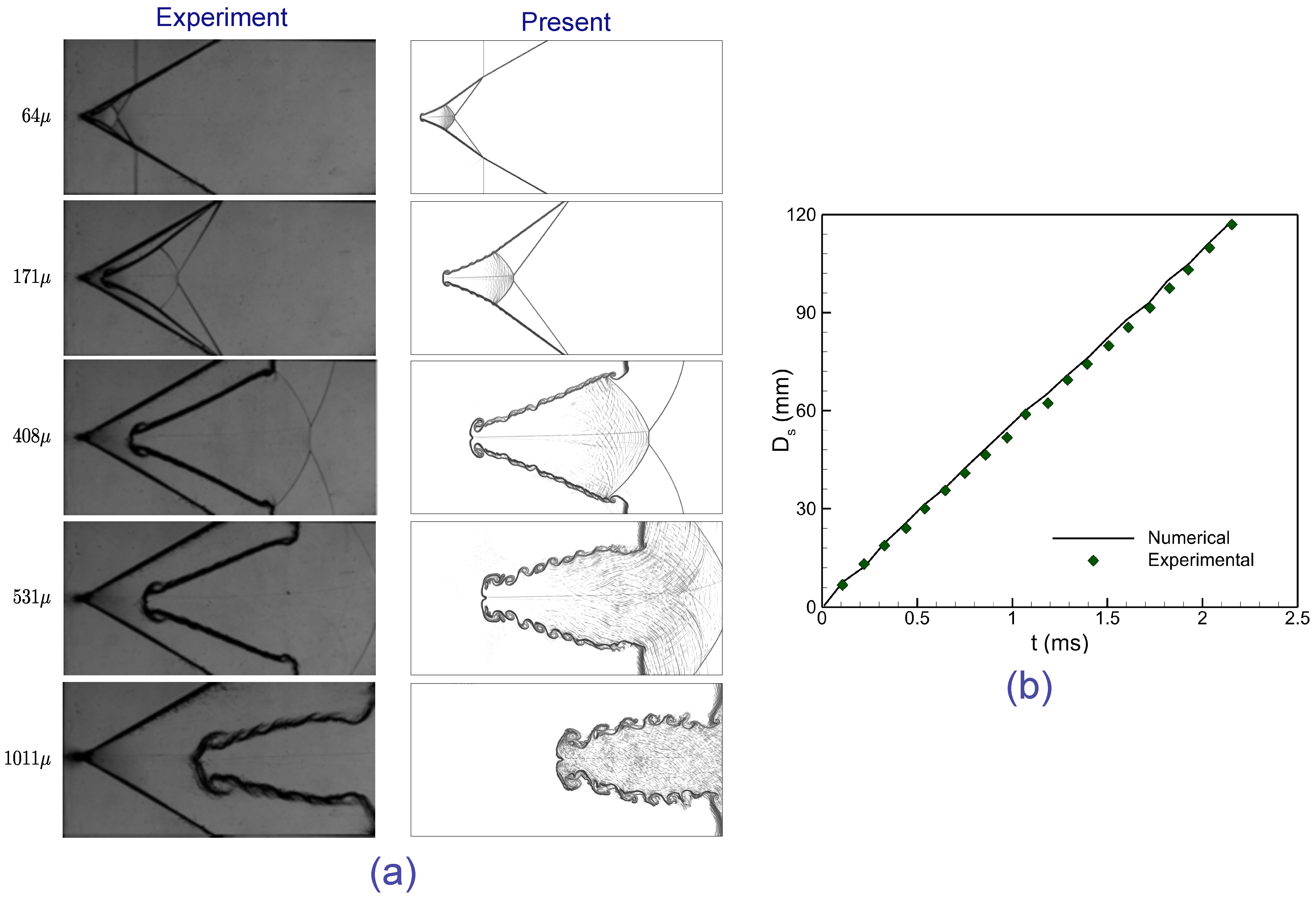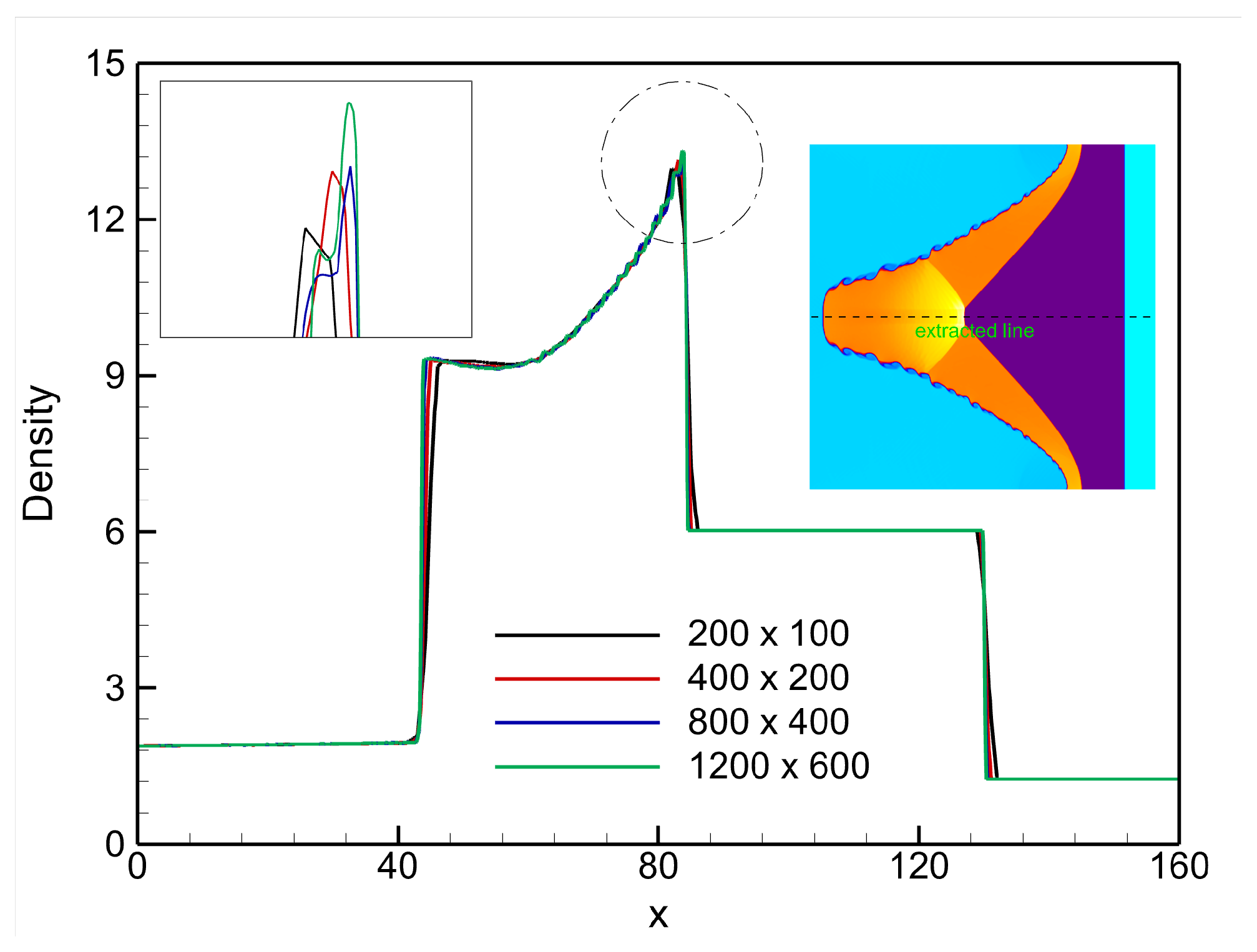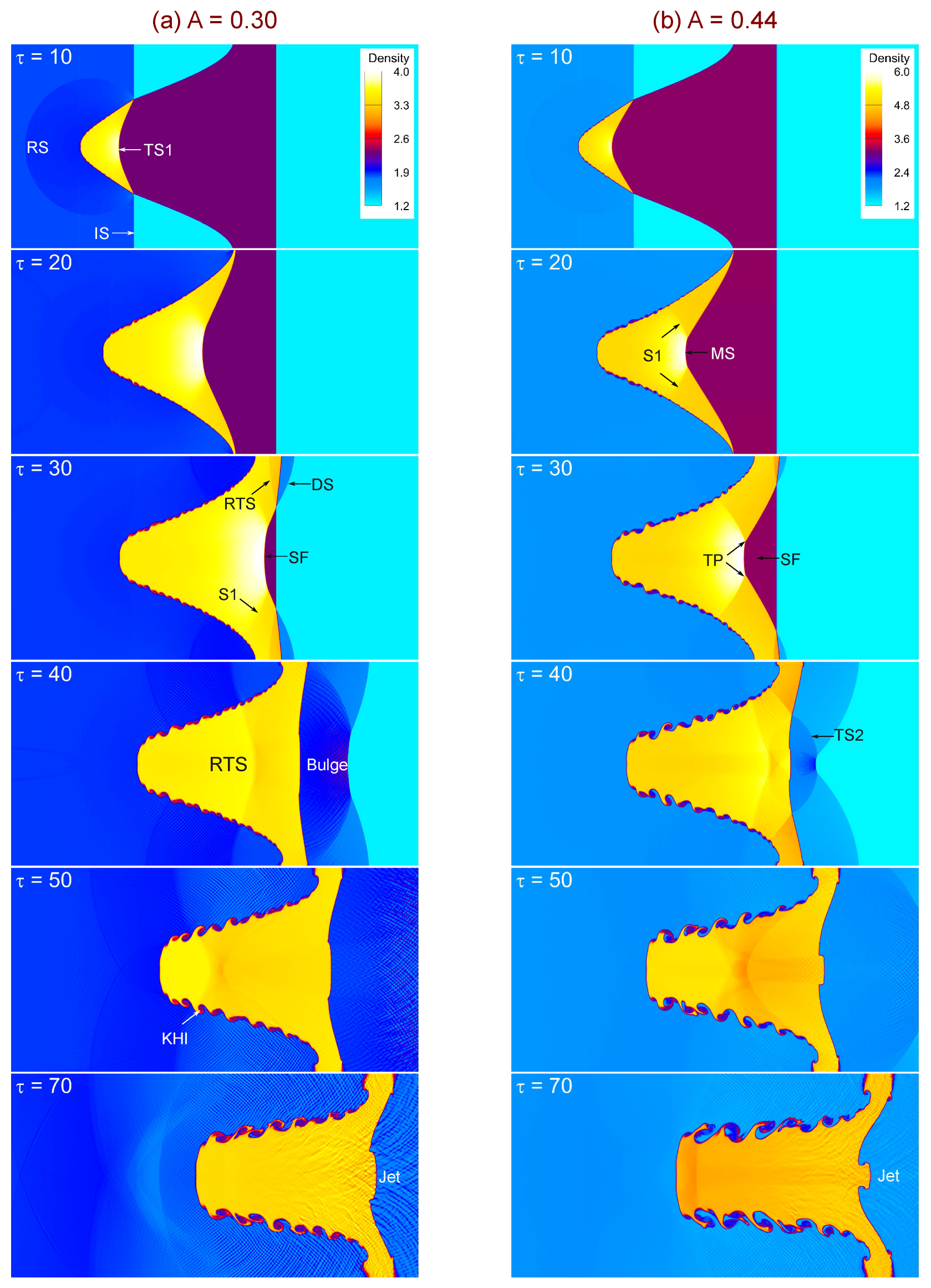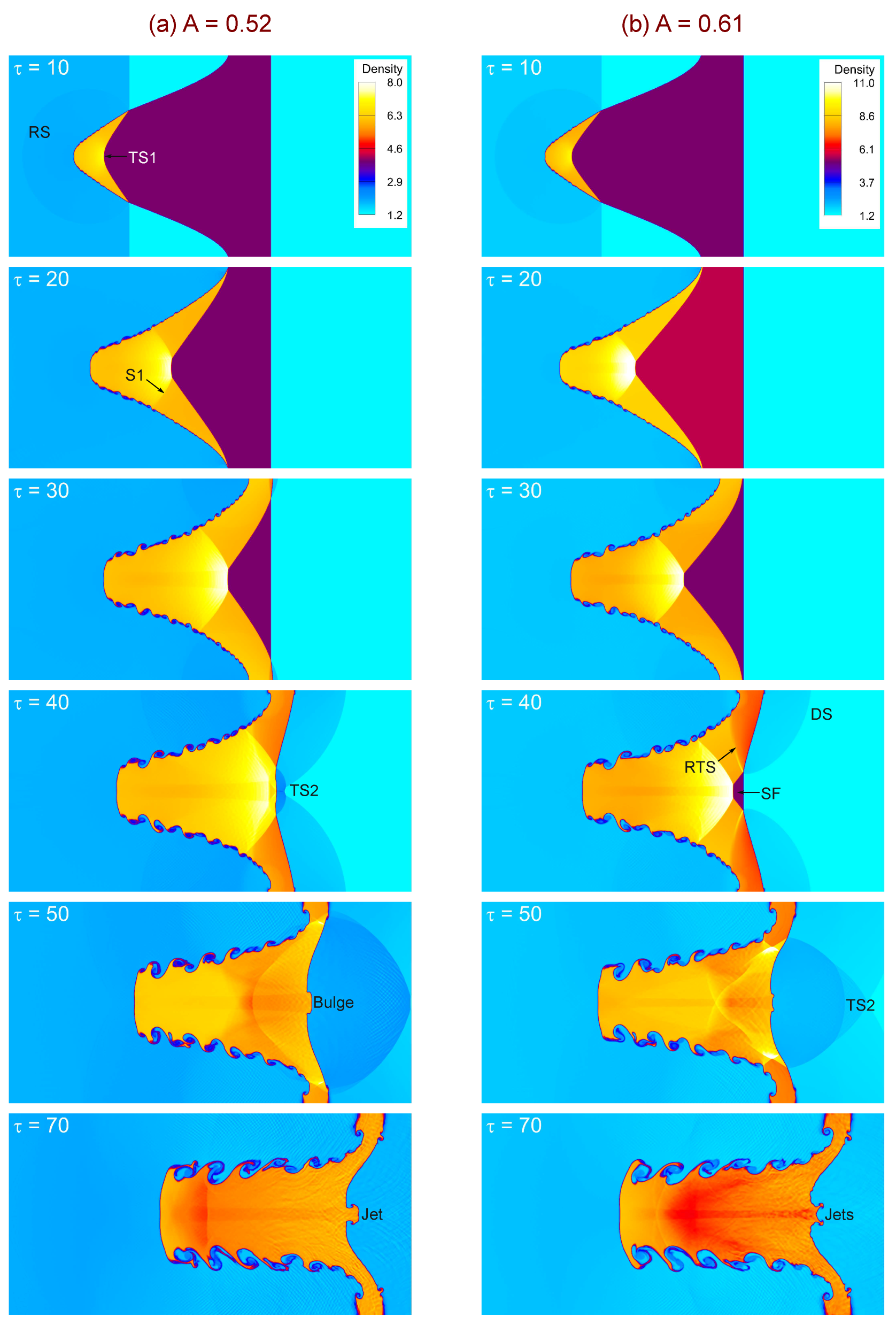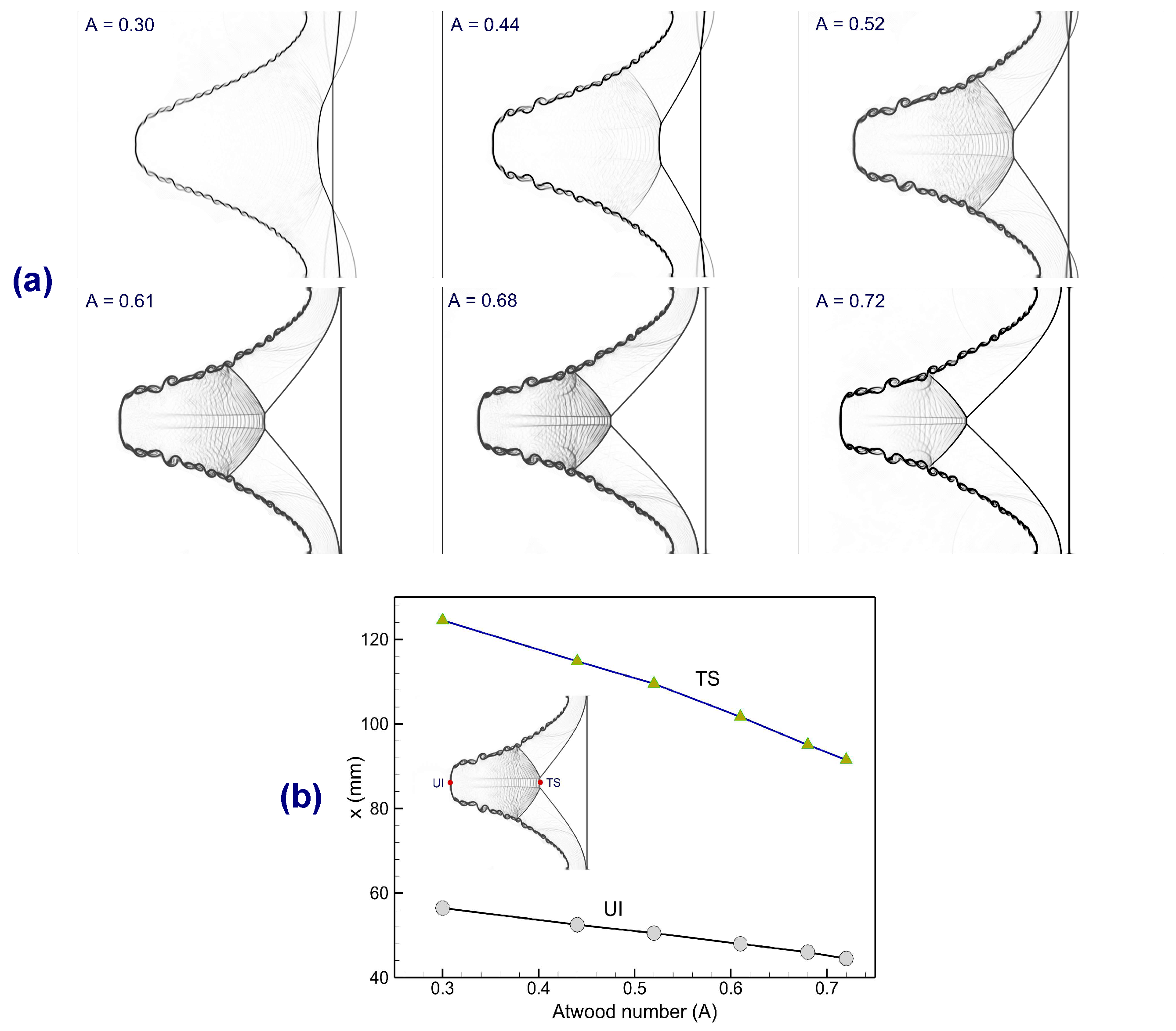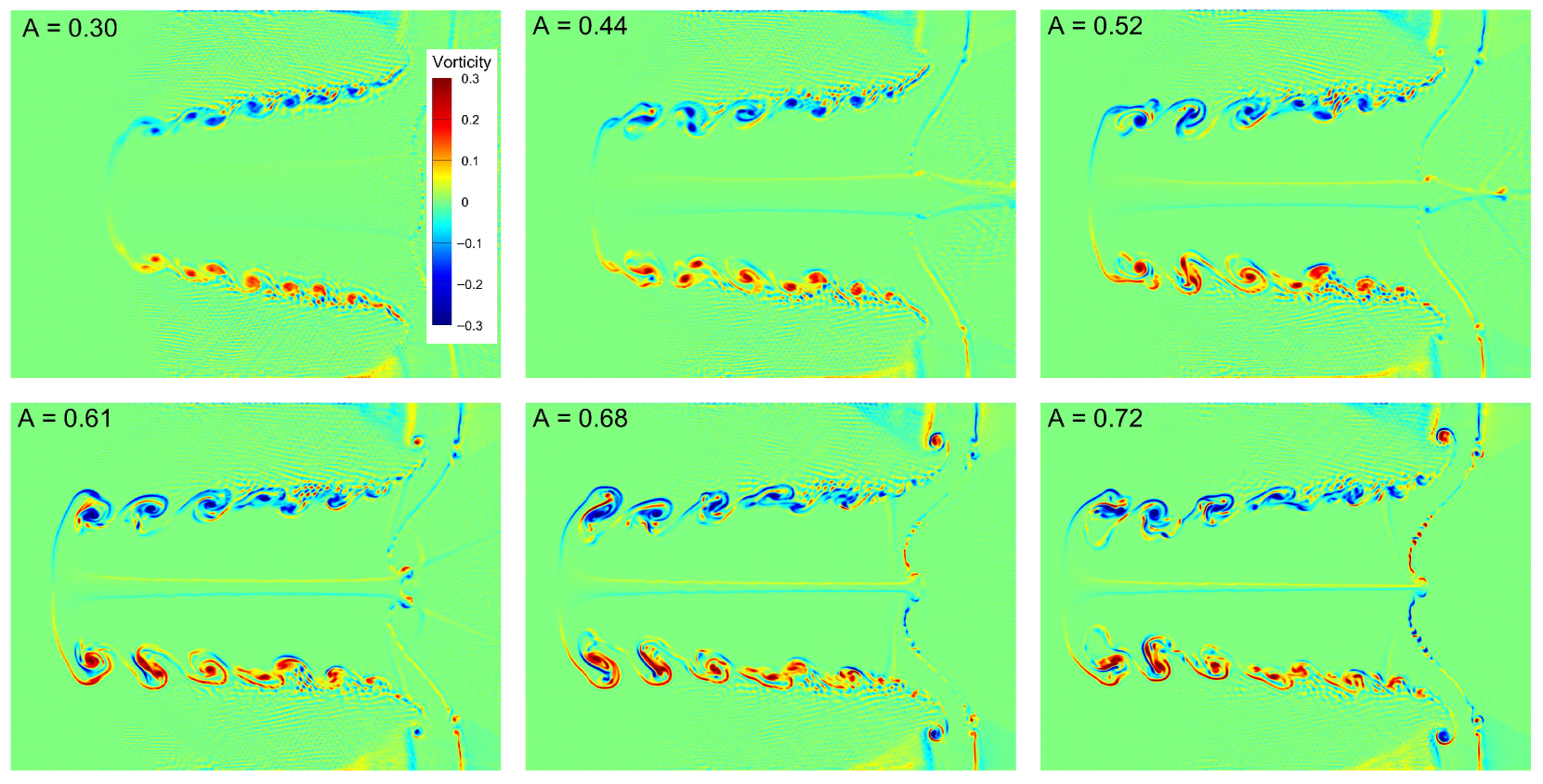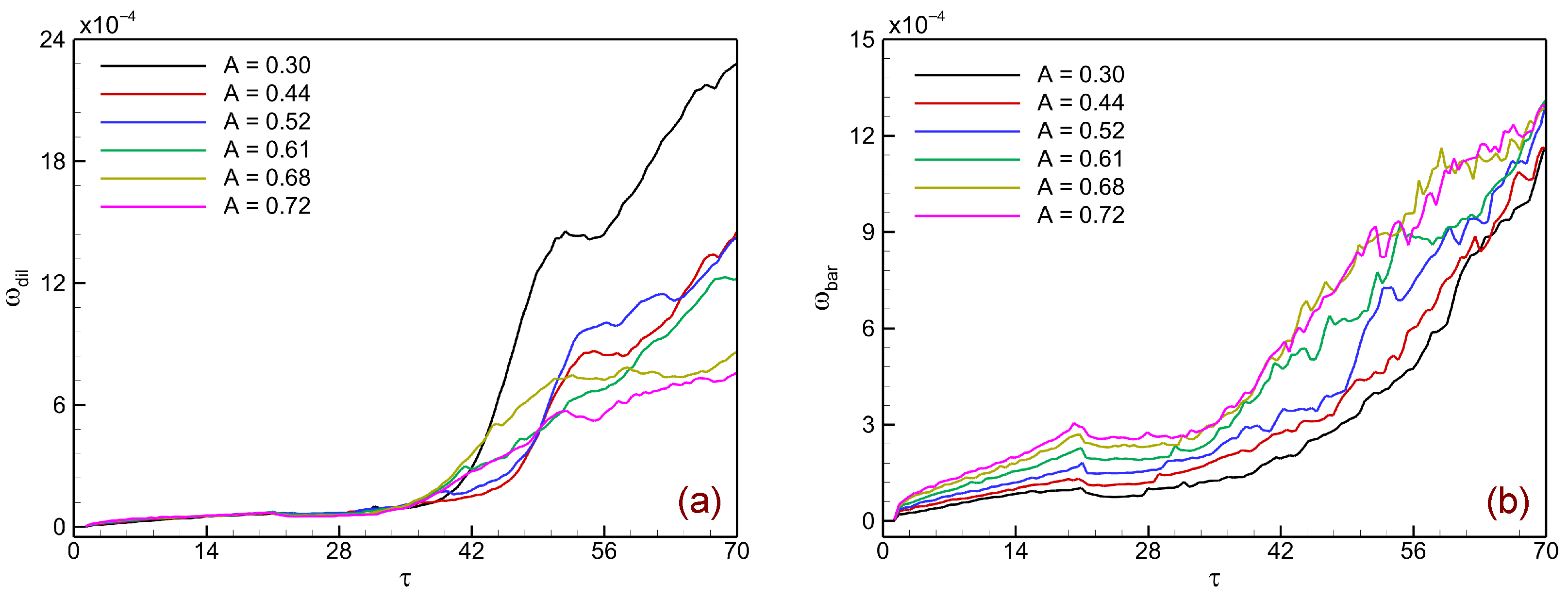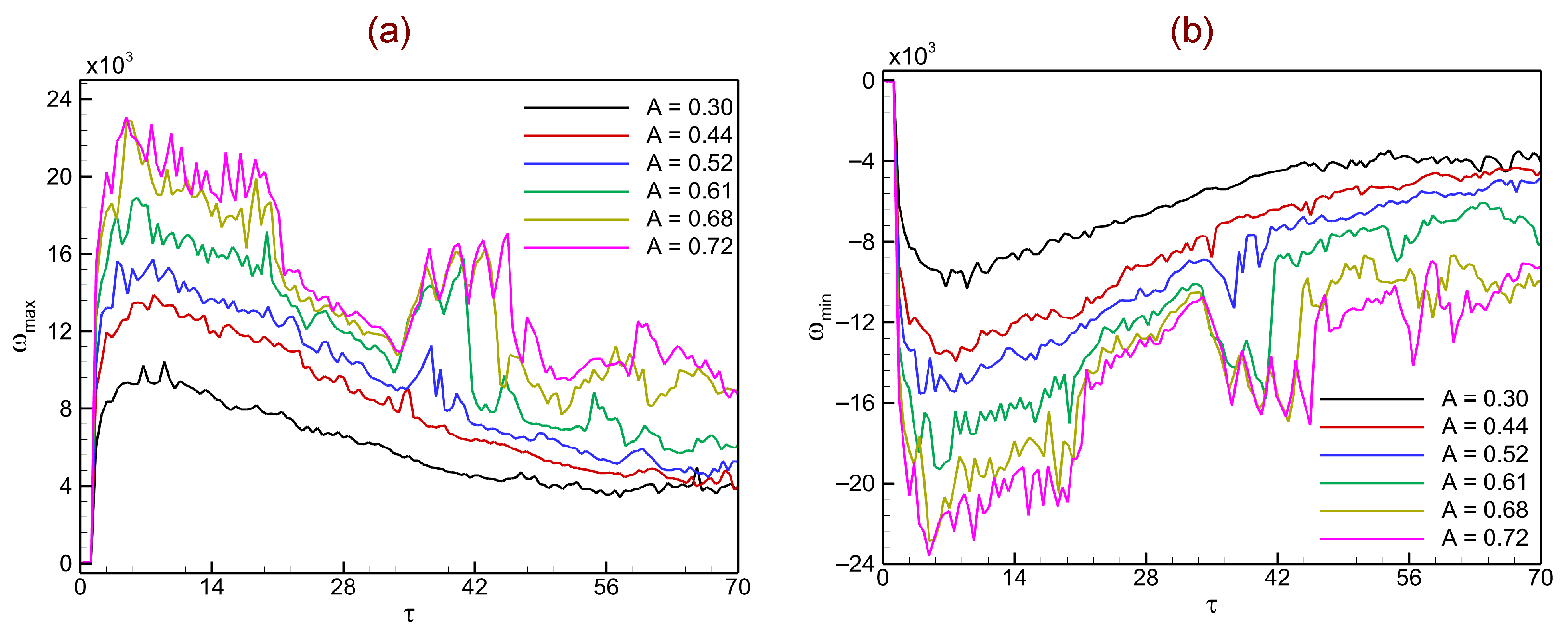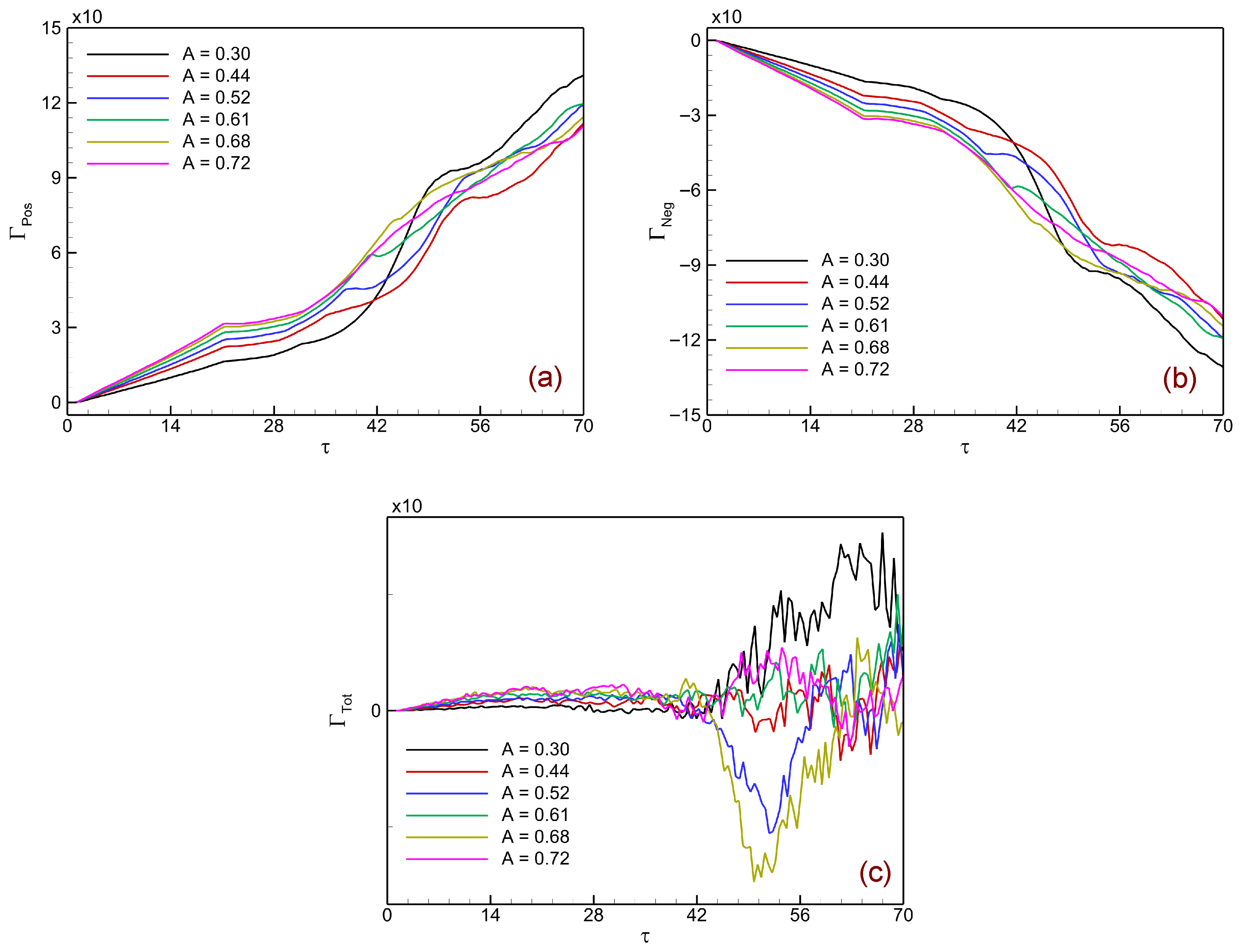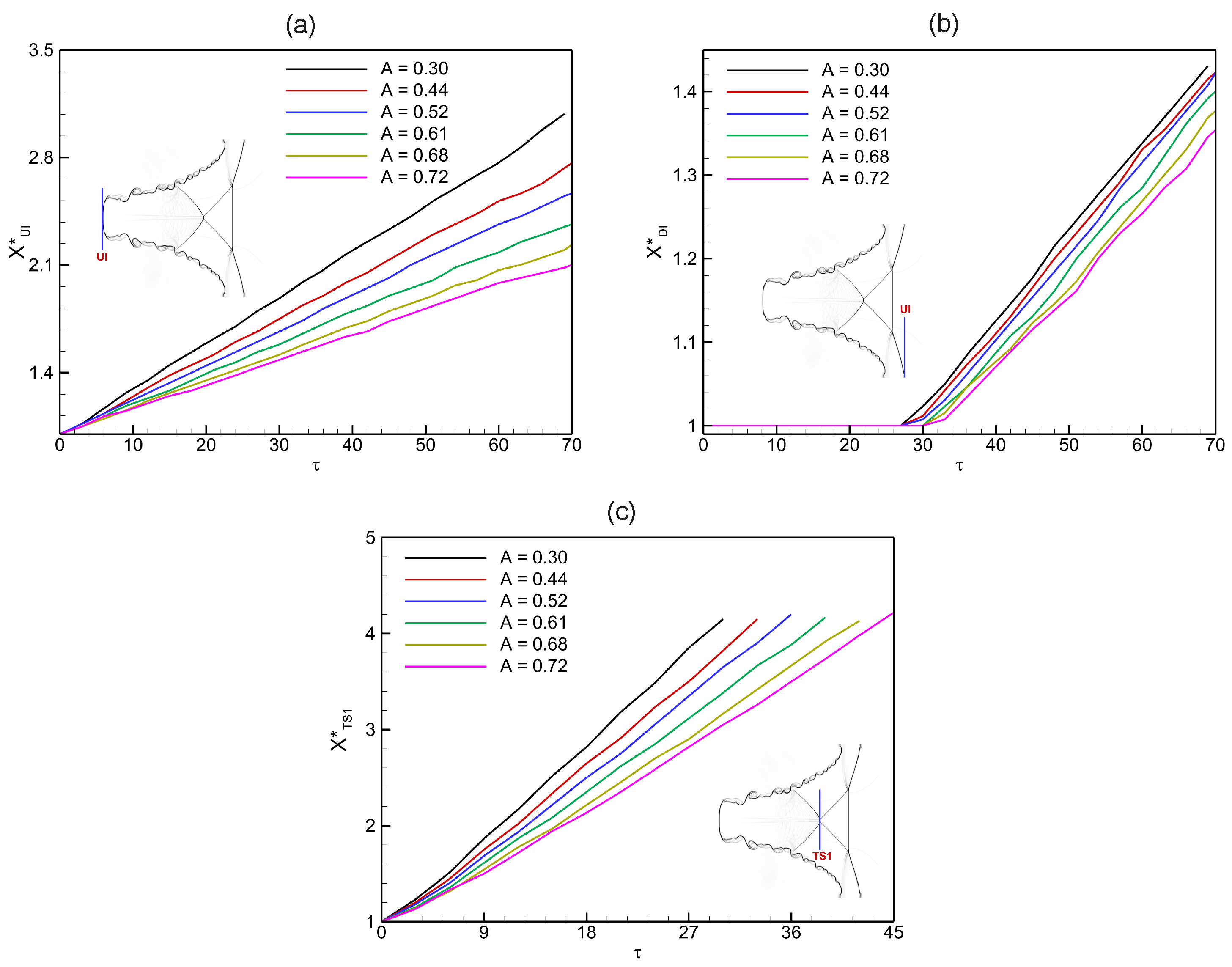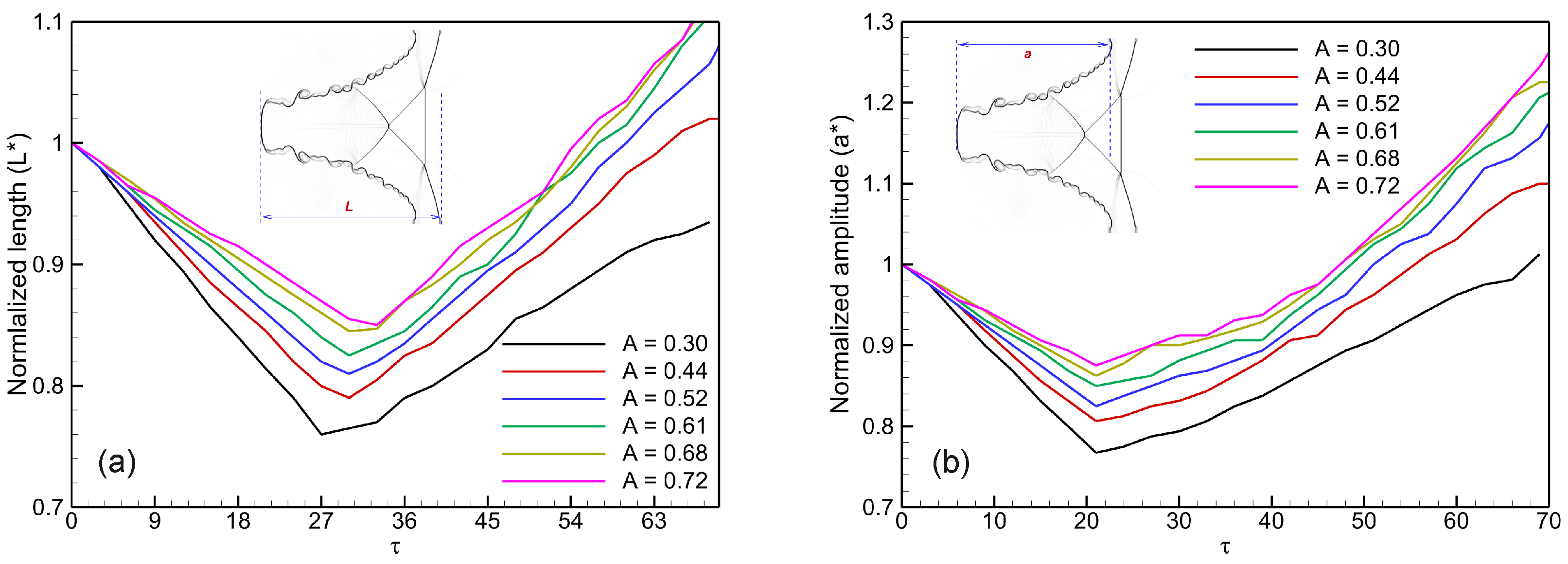This section presents the numerical results for the interaction of a planar shock wave with a sinusoidal single-mode stratified heavy fluid layer. The analysis focuses on the influence of the Atwood number on the evolution of interface morphology, shock–interface interaction, baroclinic vorticity deposition, and global flow diagnostics such as enstrophy, circulation, and kinetic energy. To achieve this, simulations are carried out for a fixed heavy-layer thickness of
, initial perturbation amplitude
, and wavelength
, with an incident shock Mach number of
. Different gas-pair configurations, as listed in
Table 1, are considered to span Atwood numbers in the range
–
, thereby providing a systematic framework to examine the role of density contrast in shock-driven instability growth and nonlinear flow evolution.
All simulations presented in this study are performed with a proprietary high-order DG solver of third-order accuracy, developed in FORTRAN 95 and compiled under Visual Studio 2019. The evolution of the flow field, including the interface deformation, vorticity generation, and instability growth, is analyzed through visualization and data post-processing carried out in Tecplot 360 (2019R1).
4.2. Interface Development and Instability Structures
Figure 6,
Figure 7 and
Figure 8 collectively illustrate the temporal evolution of shock-driven single-mode stratified heavy fluid layers at progressively increasing Atwood numbers, ranging from
to
. Immediately after shock impact, the interaction between the incident shock and the perturbed interface generates a transmitted shock (TS) propagating into the heavy fluid and a reflected shock (RS) traveling into the light fluid. The misalignment of pressure and density gradients across the perturbed interface deposits baroclinic vorticity, which drives the subsequent growth and deformation of the interface. For the lower Atwood numbers (
and
,
Figure 6), the density contrast is modest, resulting in weaker vorticity deposition and relatively smooth interface evolution. At
, the perturbation amplitude grows slowly, and roll-ups along with Kelvin–Helmholtz (KH) shear layers emerge only at later times. In contrast, at
, the stronger density gradient amplifies the baroclinic torque, producing more pronounced roll-ups, bulges, and early onset of secondary instabilities, which accelerate the transition toward the nonlinear regime.
At intermediate Atwood numbers (
and
,
Figure 7), the instability dynamics become more vigorous. For
, the interface exhibits steady amplitude growth, with clear bulging and roll-up structures appearing by
, accompanied by secondary transmitted shocks (TS2) and small-scale KH vortices. For
, the density contrast further intensifies vorticity deposition, resulting in faster perturbation growth, stronger roll-ups, and earlier development of shear-layer vortices. At later times, large bulges transform into jet-like structures and multiple small-scale vortices, signifying enhanced mixing and energy transfer. At the highest Atwood numbers considered (
and
,
Figure 8), the interface undergoes the most vigorous evolution. Already by
–30, strong baroclinic vorticity accelerates perturbation growth, with transmitted and reflected shocks interacting with the interface to further amplify deformation. For
, bulges, KH roll-ups, and jets dominate the late-time morphology, while for
, the instability develops even more violently. The higher density gradient triggers earlier onset of secondary instabilities, rapid roll-up of the interface, and stronger jet penetration, accompanied by extensive small-scale vortical structures that promote intense mixing. Taken together,
Figure 6,
Figure 7 and
Figure 8 demonstrate the systematic influence of the Atwood number on RMI dynamics. As
A increases, baroclinic vorticity deposition strengthens, leading to faster perturbation growth, earlier nonlinear transition, and more complex interface structures. Low
A values yield smoother, coherent evolution, whereas high
A values favor rapid roll-ups, jet formation, and enhanced small-scale mixing.
Figure 9 illustrates the effect of the Atwood number on the temporal evolution of interface deformation in shock-driven single-mode stratified heavy fluid layers. The interface positions are plotted at successive normalized times (
–70) for Atwood numbers ranging from
to
. For the lowest Atwood number (
), the perturbation amplitude grows slowly, and the interface remains relatively smooth and coherent throughout the evolution. The roll-ups and secondary instabilities develop gradually, with limited nonlinear distortion at later times. As the Atwood number increases to
and
, the interface exhibits stronger deformation and earlier onset of roll-ups, indicating enhanced baroclinic vorticity deposition due to the larger density contrast. At
and
, the deformation becomes more vigorous. The interface undergoes pronounced bulging and roll-up structures, while Kelvin–Helmholtz instabilities along the shear layers introduce small-scale vortices that accelerate the transition into the nonlinear regime. By
, jet-like protrusions and strong asymmetries dominate the interface morphology. At the highest Atwood number considered (
), the instability is most intense. The perturbation amplitude grows rapidly, and the interface develops large bulges, strong roll-ups, and multiple small-scale structures at earlier times compared to the lower
A cases. This highlights the sensitivity of RMI growth to Atwood number: as
A increases, baroclinic vorticity deposition strengthens, leading to faster perturbation amplification, earlier nonlinear transition, and enhanced mixing efficiency.
Figure 10 examines the effect of the Atwood number on the shock–interface dynamics at
.
Figure 10a shows numerical schlieren images for different Atwood numbers (
–
), while
Figure 10b presents the trajectories of the transmitted shock (TS) and the upstream interface (UI) as a function of
A. As the Atwood number increases, the transmitted shock penetrates more slowly into the heavy fluid layer due to the larger density contrast, which increases the impedance mismatch at the interface. Consequently, the position of the TS shifts backward with increasing
A, as clearly indicated in
Figure 10b. Simultaneously, the upstream interface exhibits stronger deformation and roll-up at higher
A, reflecting the enhanced baroclinic vorticity deposition caused by the stronger density gradient. At lower Atwood numbers (
and
), the transmitted shock propagates further downstream, and the interface remains relatively smoother, with weaker roll-ups. At intermediate values (
and
), stronger distortions appear, and the transmitted shock begins to lag. For the highest Atwood numbers (
and
), the transmitted shock is significantly slowed, and the interface exhibits pronounced bulges, KH roll-ups, and localized jet-like features. The inset in
Figure 10b highlights the relative locations of the TS and UI extracted from the schlieren field, emphasizing the increasing separation between the transmitted shock and the distorted interface with increasing
A. This systematic dependence confirms that higher Atwood numbers not only intensify interface instability but also alter the shock propagation characteristics by amplifying the interaction between the shock and the evolving interface.
4.3. Shock-Driven Vorticity Generation and Transport
The evolution of vorticity in a compressible flow can be described by the vorticity transport equation, obtained by taking the curl of the momentum equation. For a two-dimensional flow, the
z-component of vorticity
satisfies
where
is the material derivative. The terms on the right-hand side represent, respectively, vortex stretching and tilting, dilatation effects due to compressibility, and baroclinic vorticity generation.
In shock-driven flows, the baroclinic term
dominates vorticity production. It arises from the misalignment between pressure and density gradients at the perturbed interface when the shock passes through it. This mechanism deposits circulation at the interface, initiating the RMI.
Figure 11 schematically illustrates the mechanism of vorticity generation in shock-driven single-mode stratified heavy fluid layers. Before the shock arrives (pre-shock state), the interface is perturbed but remains aligned with the pressure field; thus, the gradients of density (
) and pressure (
) are largely parallel, and no baroclinic torque is generated. When the incident shock impinges on the interface (post-shock state), the pressure gradient
imposed by the shock becomes misaligned with the density gradient
at the perturbed interface. This misalignment gives rise to a finite cross product
, which acts as a baroclinic torque in the vorticity transport equation. As a result, circulation is deposited along the interface, producing localized vorticity patches with alternating signs. These baroclinically generated vortical structures are then advected and stretched along the interface, forming shear layers that subsequently roll up into vortex pairs. This marks the onset of the RMI. With time, the continuous interaction between the deposited vorticity and the evolving interface amplifies the perturbation, leading to nonlinear roll-ups, KH instabilities, and enhanced mixing.
Figure 12 shows the vorticity distribution at
for shock-driven single-mode stratified heavy fluid layers at different Atwood numbers, ranging from
to
. These distributions provide direct evidence of the role of baroclinic torque in generating and amplifying vorticity during RMI. For the lowest Atwood number (
), the vorticity field is weak, and the interface develops relatively smooth roll-ups with limited secondary structures. The circulation deposited at the interface is insufficient to drive strong nonlinear interactions, resulting in more coherent and large-scale vortices. As
A increases to
and
, the baroclinic vorticity deposition strengthens due to the higher density contrast. This leads to more intense roll-ups, larger vortex cores, and the onset of small-scale structures along the interface. At these intermediate Atwood numbers, the balance between large coherent structures and emerging fine-scale vortices characterizes the transitional nonlinear regime. For higher Atwood numbers (
,
, and
), the vorticity field becomes significantly more complex. Stronger shear layers and Kelvin–Helmholtz instabilities develop along the interface, producing fine-scale vortices that interact, merge, and break down into turbulent-like structures. Jet-like protrusions and secondary vortex shedding are also evident, demonstrating enhanced transport and redistribution of vorticity across the domain. In summary, the vorticity dynamics are strongly governed by the Atwood number. A higher
A amplifies baroclinic vorticity generation, hastens the transition to the nonlinear regime, and promotes the development of small-scale vortical structures, thereby enhancing mixing and facilitating the energy cascade in shock-driven flows.
The vorticity transport equation for compressible inviscid flows (Equation (
12)) contains two principal source terms relevant to shock–interface interactions: the dilatational contribution,
, and the baroclinic torque,
. While the dilatational term reflects compressibility effects associated with local expansion and compression of fluid elements, the baroclinic term provides the dominant source of vorticity production in RMI. To quantify the evolution of these contributions, spatially integrated measures are defined over the computational domain
D:
where
and
denote the global strength of dilatational and baroclinic vorticity contributions, respectively.
Figure 13 presents the temporal evolution of the spatially integrated contributions of dilatational and baroclinic vorticity in shock-driven single-mode stratified heavy fluid layers at different Atwood numbers.
Figure 13a shows the dilatational vorticity
, which remains relatively small across all Atwood numbers. Its contribution grows slowly in the early stages (
) and only becomes noticeable at later times (
), primarily due to local compression and expansion effects caused by secondary shock interactions. Even at its peak, however, the dilatational contribution is at least an order of magnitude weaker than the baroclinic source, confirming its secondary role in driving interface dynamics.
Figure 13b shows the baroclinic vorticity
, which dominates the overall vorticity budget. Right after shock impact,
grows sharply as a result of strong misalignment between the pressure and density gradients across the perturbed interface. Its growth continues as the transmitted and reflected shocks interact with the interface, reinforcing the vorticity field. The results also show a clear dependence on Atwood number: as
A increases, the baroclinic contribution systematically intensifies, reflecting the enhanced density gradient and stronger shock–interface coupling. The comparison between
Figure 13a,b highlight that baroclinic torque is the primary mechanism for vorticity generation in RMI, while dilatational effects act as a minor correction. Moreover, the monotonic increase of
with
A directly links stronger density contrast to greater instability growth, more vigorous roll-ups, and enhanced mixing.
To further quantify the strength of vortical structures generated during the instability, we examine the temporal evolution of the maximum and minimum vorticity within the computational domain. These measures provide a direct indication of the intensity of circulation deposited along the perturbed interface and the subsequent development of roll-ups and small-scale vortices. Mathematically, the extrema are defined as
where
is the scalar vorticity field in two dimensions, and
D denotes the computational domain. In the discrete form used for numerical simulations, these are computed at each time step as
Tracking
and
allows us to assess the asymmetry between positive and negative vortical regions, and to evaluate how increasing the Atwood number amplifies baroclinic circulation and accelerates the transition to nonlinear dynamics.
Figure 14 shows the temporal evolution of the maximum vorticity
and minimum vorticity
in shock-driven single-mode stratified heavy fluid layers for a range of Atwood numbers. These diagnostics quantify the extrema of circulation deposited along the interface and highlight how positive and negative vortical regions evolve during RMI.
Figure 14a illustrates
. Right after the shock impact (
),
rises sharply due to strong baroclinic vorticity deposition at the interface. For higher Atwood numbers (
–
), this peak is considerably larger, reflecting the stronger density gradients that enhance baroclinic torque. Over time,
exhibits oscillations associated with secondary shock–interface interactions and vortex roll-ups. Although the peak values gradually decay due to redistribution of circulation and mixing, higher-
A cases consistently maintain stronger positive vorticity levels compared with lower-
A cases.
Figure 14b presents
, which captures the evolution of negative vorticity regions. Immediately after shock passage,
drops sharply, indicating the generation of strong counter-rotating vortices at the interface. Similar to
, the magnitude of
increases with the Atwood number, with the strongest negative vortices observed for
and
. As time progresses,
continues to fluctuate due to nonlinear vortex interactions, roll-up, and merging of small-scale structures. Together, both positive and negative vorticity extrema grow systematically with the Atwood number, confirming that higher
A values intensify baroclinic circulation deposition and accelerate the onset of nonlinear roll-up. This asymmetry between
and
further reflects the directional nature of vortex formation during shock–interface interaction, with high-
A cases promoting stronger mixing and more vigorous turbulent-like dynamics.
Circulation is a fundamental quantity for characterizing the strength and evolution of vortical structures in shock-driven flows. In the context of RMI, it directly measures the baroclinically generated vortices at the perturbed interface and provides insight into the balance between positive and negative rotational motions. The total circulation in the flow field is defined as the spatial integral of vorticity over the computational domain
D:
For further analysis, the circulation can be decomposed into its positive and negative components, representing the contributions from counter-rotating vortical regions:
These diagnostics provide a quantitative measure of the circulation deposited along the perturbed interface through baroclinic torque. While
and
capture the evolution of positive and negative vortices generated at the interface, their sum yields the net circulation
.
Figure 15 illustrates the influence of the Atwood number on the temporal evolution of circulation in shock-driven single-mode stratified heavy fluid layers, separated into positive circulation
, negative circulation
, and the net total circulation
.
Figure 15a shows the growth of
, which represents the contribution from regions of positive vorticity. After shock impact,
increases steadily due to baroclinic deposition of circulation at the interface. Higher Atwood numbers (
–
) exhibit systematically larger values, reflecting stronger density gradients and enhanced baroclinic torque.
Figure 15b presents
, which corresponds to the negative vorticity regions. Similar to the positive component, the magnitude of
grows with the Atwood number, reaching increasingly negative values as
A increases. This indicates stronger counter-rotating vortices generated along the interface at higher density contrasts.
Figure 15c shows the net total circulation
. At early times, the positive and negative contributions nearly balance, keeping
close to zero. However, as the instability progresses into the nonlinear stage, asymmetry between the positive and negative vortical regions emerges, leading to fluctuations in
. These deviations are more pronounced at higher Atwood numbers, where stronger secondary instabilities and vortex roll-ups introduce localized imbalance in circulation deposition.
4.4. Enstrophy and Kinetic Energy Dynamics
Enstrophy and kinetic energy are fundamental diagnostics for characterizing the evolution of shock-driven instabilities. While enstrophy quantifies the amplification of vortical structures generated through baroclinic torque, kinetic energy reflects the redistribution of bulk flow energy into interface deformation and small-scale motions.
For a two-dimensional flow, enstrophy is obtained by integrating the squared vorticity over the computational domain
D
which serves as a measure of the overall strength of vortical activity in the flow field.
The total kinetic energy in the domain is defined as
providing a measure of the bulk flow energy and its transfer into smaller-scale structures during the nonlinear RMI development.
Figure 16 illustrates the temporal evolution of enstrophy
and kinetic energy
in shock-driven single-mode stratified heavy fluid layers for different Atwood numbers. These diagnostics provide insight into the development of vortical structures and the redistribution of energy during RMI. In
Figure 16a, enstrophy
exhibits a sharp rise immediately after shock impact, driven by intense baroclinic vorticity deposition along the perturbed interface. The subsequent growth reflects the amplification of vortical structures, roll-up of shear layers, and the emergence of secondary instabilities. At lower Atwood numbers (
and
), enstrophy growth is relatively weak and saturates at modest levels, indicating smoother interface evolution with limited nonlinear roll-up. By contrast, at higher Atwood numbers (
–
),
exhibits significantly larger values, reflecting the stronger density gradients that intensify vorticity generation and promote complex small-scale vortical interactions. The oscillations observed in the time histories correspond to secondary shock–interface interactions and vortex pairing events, which periodically enhance and redistribute enstrophy. In
Figure 16b,
grows steadily in the early stages (
) across all Atwood numbers as the shock deposits momentum into the fluid layer and drives bulk motion. After this initial growth,
tends to plateau, indicating a transfer of energy from large-scale interface deformation into smaller-scale vortical and mixing structures. The results reveal only a weak dependence of kinetic energy on the Atwood number compared to enstrophy. While higher-
A cases reach slightly larger peak values of
, the overall similarity of the curves suggests that the primary role of the Atwood number is not in setting the global energy level, but rather in controlling how that energy is redistributed into vortical motions, as captured by the enstrophy dynamics.
4.5. Interface Characteristics and Growth
This section presents the evolution of interface characteristics and growth in shock-driven single-mode stratified heavy fluid layers. The analysis focuses on interface trajectories, normalized length, and perturbation amplitude to assess how baroclinic vorticity deposition and shock interactions influence deformation and instability growth. These diagnostics provide direct measures of the Atwood number effects, capturing both large-scale displacement of the interface and the emergence of small-scale structures that enhance mixing.
Figure 17 shows the influence of the Atwood number on the temporal evolution of interface trajectories in shock-driven single-mode stratified heavy fluid layers. Three normalized quantities are examined: the upstream interface position (
), the downstream interface position (
), and the transmitted shock position (
).
Figure 17a depicts the normalized upstream interface trajectory
. Following the incident shock impact, the upstream interface moves steadily in the positive
x-direction due to the momentum imparted by the shock. The growth rate increases systematically with Atwood number, as larger density contrasts enhance baroclinic circulation deposition and accelerate interface displacement. High-
A cases (
,
) show noticeably faster progression compared to low-
A cases.
Figure 17b shows the normalized downstream interface trajectory
. The displacement of the downstream interface occurs at a slower rate than that of the upstream side, reflecting asymmetry in interface response due to shock refraction and density contrast. With increasing Atwood number, the downstream motion becomes more pronounced, consistent with the stronger interface deformation and amplified instability growth.
Figure 17c illustrates the normalized trajectory of the transmitted shock
. The transmitted shock penetrates deeper into the heavy fluid layer as time progresses, but its propagation speed decreases with increasing Atwood number. This behavior arises from the larger density ratio across the interface, which increases the impedance mismatch and slows the transmitted shock.
Figure 18 illustrates the effect of the Atwood number on the temporal evolution of interface morphology, quantified in terms of normalized interface length (
) and normalized perturbation amplitude (
). These diagnostics provide complementary measures of interface deformation and growth during the RMI.
Figure 18a shows the evolution of the normalized interface length
. Immediately after shock passage,
decreases, reflecting the initial compression of the interface by the incident shock. As time progresses,
begins to increase due to baroclinic vorticity deposition and the roll-up of shear layers, which enhance interface wrinkling and extend the interface surface area. The rate of increase becomes stronger with higher Atwood numbers (
–
), demonstrating that stronger density contrasts promote more vigorous deformation and generation of small-scale structures. In contrast, lower-
A cases show a more modest increase in
, consistent with smoother interface evolution.
Figure 18b presents the evolution of the normalized perturbation amplitude
. Similar to
, the amplitude initially decreases due to shock compression, before recovering and growing rapidly during the nonlinear phase of instability development. The recovery and subsequent growth of
are strongly dependent on Atwood number: higher-
A cases show faster amplitude growth and reach larger values, while lower-
A cases remain subdued. This behavior reflects the enhanced baroclinic torque at higher density contrasts, which accelerates the transition from linear to nonlinear interface evolution.

